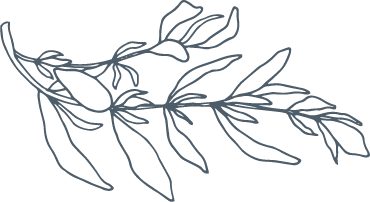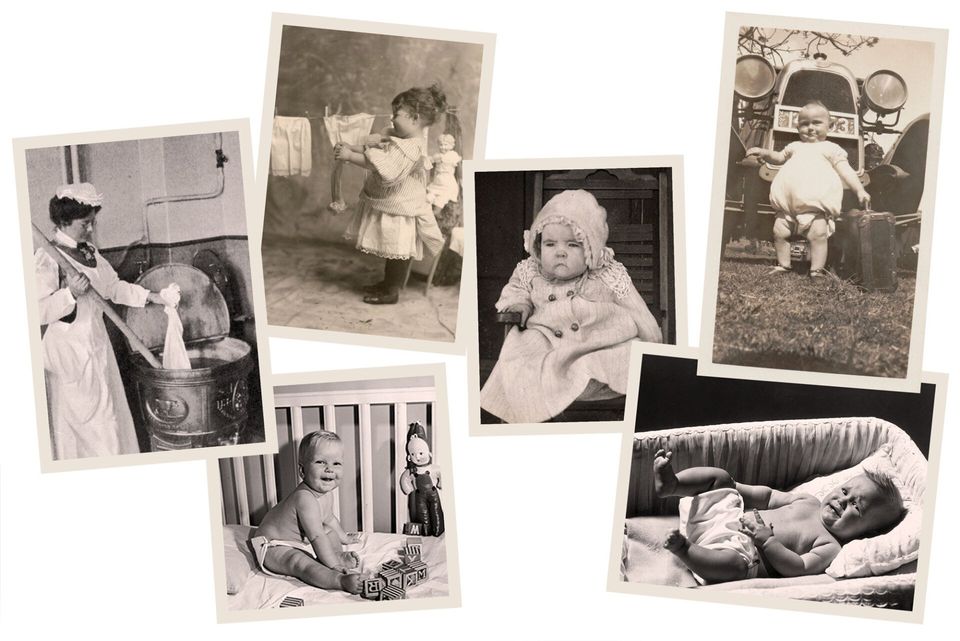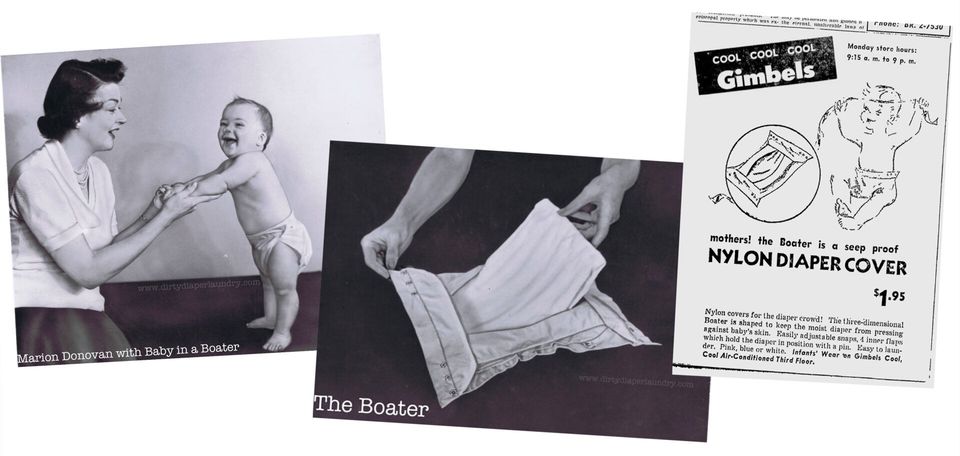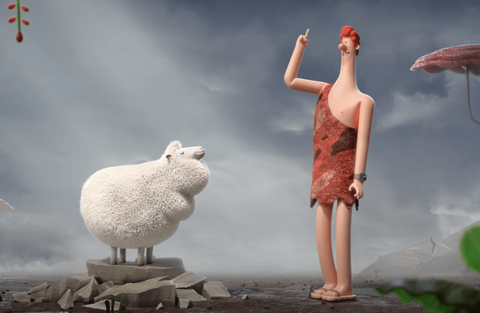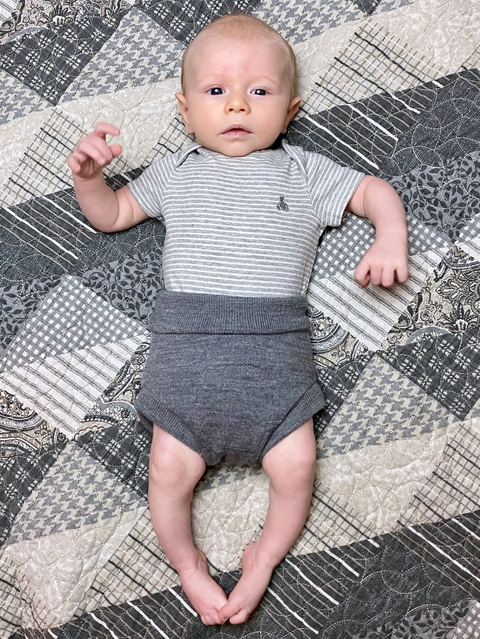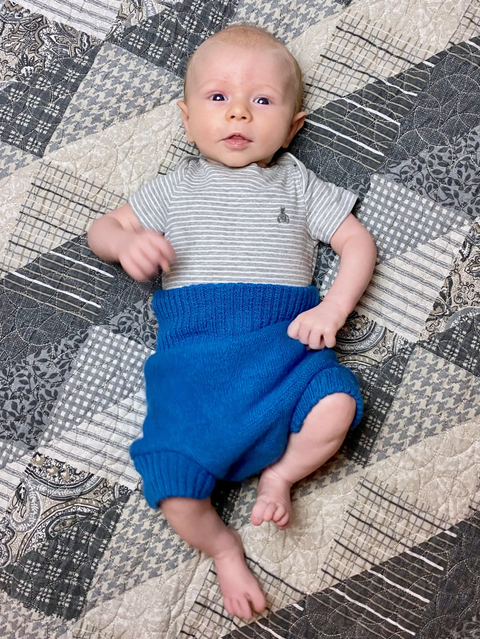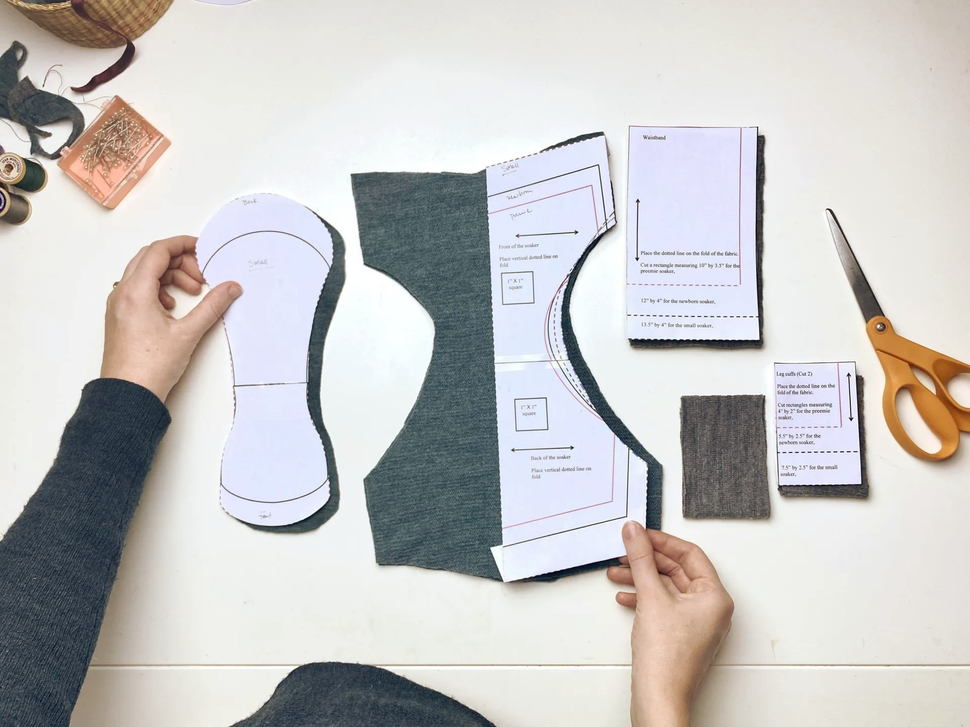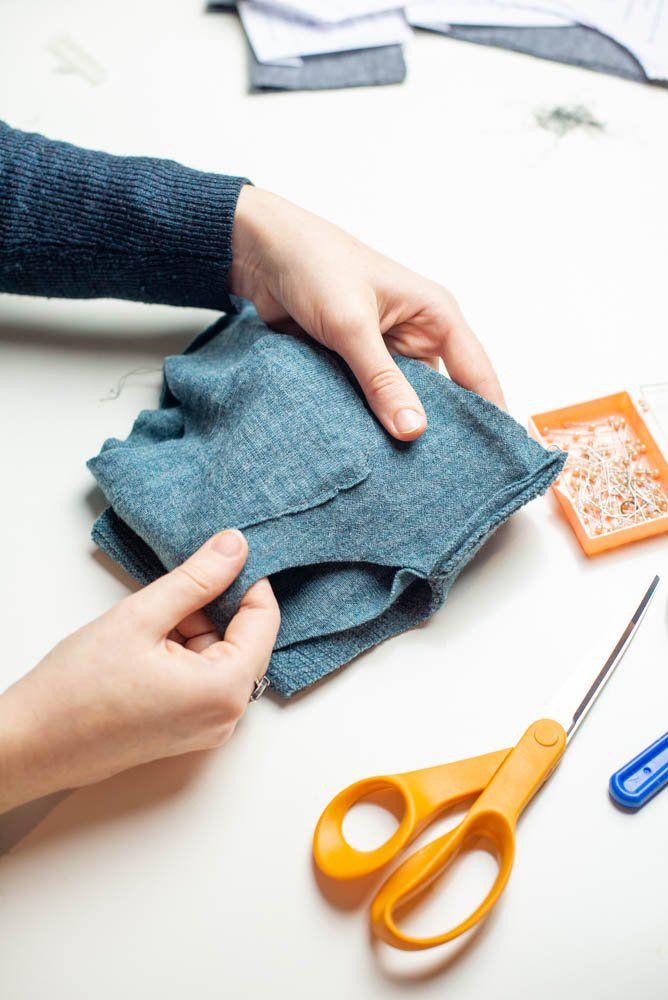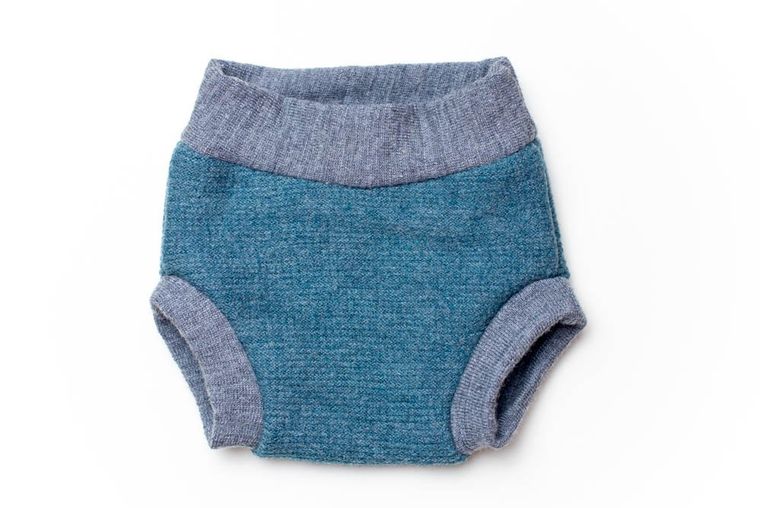DIY Wool Soakers for Cloth Diapering
DIY Wool Soakers for Cloth Diapering
What is a Wool Soaker?
If you had asked me that question last year, I probably would have guessed it was something used back in the fifties in connection with a cloth diaper that you needed to be proficient in origami to know how to fold. It sounds old fashioned, like the pre-cursor to what a baby wore before graduating to knickers. Worn in the era when every baby looked like a little girl. And, no doubt the wool was horribly scratchy... just something our great-grandparents had to suffer through while they waited for things like plastic, modern dentistry and electricity... right?
While these images looks humorous to the modern woman, cloth diapering is no joke. And our great-grandmothers knew what they were doing. After all, they couldn't just throw babies' soiled nappies into the washing machine, it was all done by hand. So, you better believe they came up with some ways of keeping their little ones dry long before disposable diapers came on the scene in the 1950's.
History Note:
"When it comes to the history and legend behind cloth diapers the Boater cannot be ignored. The inventor, Marion Donovan, was a new mother solving the age old problem of leaky diapers... Legend has it that Marion Donovan was in her bathroom and the waterproof shower curtain caught her eye. She immediately had that light bulb moment and went about cutting from it a section and went to work with her sewing machine... The diaper came to be known as the “Boater” because, as her husband Jim, a sailing enthusiast, said “Call it boater, because, like a good boat, it’s leakproof.” - DirtyDiaperLaundry.com
"Disposable diapers were developed by Marion Donovan after World War II due to a cotton shortage. It wasn't long, however, before mothers realized the practical everyday benefits of Donovan's 1950 diaper design: a rectangular plastic covering (initially made from shower curtains) over layers of tissue paper." - BabyGearLab.com
Back to our original question, what is a wool soaker?
"Wool soakers (also called longies, woolies, shorties and soakers) are diaper covers made from 100% wool designed to be worn over Flat, Fitted, Prefold and Contour cloth diapers. Wool soakers are typically made from Angora or Merino wool and are extremely soft, breathable, and naturally antibacterial. The beauty of wool soakers is that they can absorb up to one-third of their own weight in water, they're naturally antibacterial and they breathe extremely well so they can be worn in both warm and cold months. For this reason they are great for use during both day and night." - PootersDiapers.com
Hold it right there, 100% wool on my baby? Yes, that's right! But wait,
Isn't All Wool Scratchy?
No, it's not. In fact, "Merino wool can be softer than cashmere and smoother than silk." - Woolmark.com
Some advantages of merino wool are that:
- It's Natural
- It Helps Regulate Body Temperature
- It Helps Keep You Dry and Sweat-Free
- It Likes It When You Layer
- It Resists Odors
- It Is Soft
- It’s Biodegradable
- It Helps Provide UPF Protection
- It’s Fire-Resistant
Since learning several years ago about how amazing merino wool is, it's since become a staple in my winter wardrobe. It's amazing!
Please take 2 minutes and enjoy this super cute video: The Innovator by The Woolmark Company.
You might just need to purchase some merino wool for yourself and your baby!
How Do Wool Soakers Work?
"When the diaper becomes wet, the wool soaker wicks the moisture away from the diaper by absorbing it. Lanolin, a natural oil that comes from sheep, keeps the urine from leaking back out of the wool quickly. Over time, the lanolin needs to be replaced (roughly every 2 to 3 weeks) to help the wool soaker maintain its super absorbent abilities. This is done through a process called lanolizing. Lanolizing cleans the wool and restores the lanolin to the cover. In between use, air out your wool soaker by laying it flat. This will allow the cover to dry and will eliminate any odors that may be in the wool cover. If poop gets on the diaper cover, you will need to clean and lanolize immediately." - PootersDiapers.com
Do I Need to Use Wool Soakers If I'm Planning to Cloth Diaper?
"Need" is a highly relative term. Based on my own personal experience (two months in on my cloth diapering journey), I would say yes! But, I've only tried a handful of cloth diapers. What I've found is, yes they leak. I remember one of the first times my sister-in-law was holding our son he peed... soaked right through his cloth diaper and christened her blouse. She handled it with grace like the experienced auntie she is, but I was so embarrassed. I wanted our friends and family to enjoy our son, not back away for fear of getting soaked while I tried to figure out cloth diapering. It was then that I remembered the wool soakers I'd picked up by chance at a local thrift store. These proved to be a providential find since I may not have been willing to fork over the big bucks initially. But, having picked these up for pennies I was able to try out wool soakers without the hefty price tag and instantly became a fan.
Our Wool Soakers
These are the wool soakers we currently have. If you plan to use them full-time like we do (during the day and night), then at least eight seems to be a good number to have in your rotation.
Starting at the top left:
- The white, orange and yellow pairs are by Luxe Baby. Luxe soakers are interlock wool which is 97% wool and 3% lycra. I picked these up at a local thrift store.
- The blue pair is 100% merino wool by Disana and I purchased them here.
- The two tan pairs and the grey pair are made from 100% merino wool sweaters, up-cycled into soakers using
Katrina's Sew Quick Soaker Pattern available FREE on her blog.
- And lastly, the knitted pair with green trim is made from 100% merino wool yarn using the Curly Purly Soaker Pattern available FREE on Ravelry.
History Note:
"The baby boom coupled with the shortage of rubber (just enough for elasticized waistlines and paint legs of ‘waterproof’ panties) contributed to the wool soaker’s hey-day of the 1940’s. Stores took advantage of this fact and stocked more patterns and kits, like soaker kits from Bucilla for $0.50, for mothers to create. These soakers were simple with a drawstring closure. Some featured ribbed cuffs around the legs and waist. 'I had four children between 1938 and 1946 and during the intervening years whenever I had any slack time I knitted only one article, SOAKERS, but I did it two hundred times.' " - DirtyDiaperLaundry.com
What is working?
I've found the Luxe soakers to be thin but adequate, but the leg holes a little too big. I plan to remedy this by knitting around the leg holes to make them a little more fitted. The pair by Disana is great, but I find the fact that it becomes an outfit (pants) by itself a little limiting. But still, the design is excellent and the quality superb. These are a great overnight option.
I was thrilled to find Katrina's pattern. I made the mistake of trying to hand sew the first two pairs. While cathartic, it proved a waste of time in the end since I prefer the look of the ones I did on the sewing machine (one of which is the grey pair) so much more.
The knitted pair I just can't recommend. Perhaps if knit with a thicker wool, or doubled it might work well. But, as a soaker it just doesn't do much of anything towards locking in the leak.
Our son is two months old in these photos. On the left is a pair I sewed on the sewing machine using Katrina's pattern, and on the right is the Disana pair. Normally I snap his onesies on the outside of the soaker, but for the photos I tucked it inside. Isn't he just precious? : )
DIY Wool Soaker: Supplies
- Katrina's Sew Quick Soaker Pattern available FREE on her blog
- 100% merino wool*
- Scissors
- Pins
- Needles
- Thread
- Sewing machine
*I recommend picking up some sweaters at your local thrift store. It's ok if they are a little felted, just so long as they aren't super wonky. You'll be more pleased with the end result if you choose ones that are either not felted, or only a little felted. Also, these don't have to be super pricey. Hunt around, some thrift stores are cheaper than others. Sometimes they are priced differently in the men's section.
I found this list (linked below) to be so interesting... which one of these surprises you the most?
11 Surprising Diapers Parents Used On Their Babies Throughout History
History Note:
"For much of history, infant sanitary needs were handled by putting absorbent material (moss, rags) into a sort of sling under the baby; the absorbent material was periodically replaced. The word “diaper” originally referred to the fabric – a type of linen – and not to its use on babies. The first known mention of a diaper was in William Shakespeare's “The Taming of the Shrew.” Unfortunately, in Elizabethan times the diaper was only changed every few days. Yuck! In the early 1800s, a cloth diaper was a square or rectangle of linen, cotton flannel, or stockinet that was folded into a rectangular shape, and knotted around the baby’s bottom. These were often hung to dry, if they were only wet, but seldom washed. When the safety pin was invented in 1849, those were then used by those that could afford the pins to hold the rectangular diaper in place. In 1887, modern cloth diapers were invented and began to be mass produced as squares of linen or flannel folded into a triangle and held in place with a safety pin. Around this time, mothers also started boiling dirty diapers to sanitize them before reuse. Wool soakers, tight wool pants or shorts were used as diaper covers and worn over diapers to keep clothing dry until 1946, when the plastic diaper cover was invented. Disposable diapers first appeared on the market in the early 1960s." - KangaCare.com
Once you've assembled your supplies, print out the pattern and cut out your pattern pieces. The sweater I used was a bit thin, so I opted to double the fabric for the main section. Note how the pattern has you lay it out with the fabric folded along the dotted line.
Because I doubled the fabric for the main body of the soakers, I was able to hide my side seams and the extra layer in the middle inside the fabric so it wasn't visible when finished. I then pinned on the waist and leg bands and sewed those on. The whole thing sews up delightfully fast, it's very rewarding! Especially since my little one's naps are still so short.
And there you have it, the finished soakers!
To finish up this post, a word about caring for your new soakers. Probably one of the aspects that is the most daunting about using wool soakers, and wool in general, is the care. Yes, they do need to be hand washed and periodically lanolized, but the process isn't scary or even especially time consuming. First off,
What is Lanolin?
"Lanolin (from Latin lāna 'wool', and oleum 'oil'), also called wool yolk, wool wax, or wool grease, is a wax secreted by the sebaceous glands of wool-bearing animals... Historically, many pharmacopoeias have referred to lanolin as wool fat (adeps lanae); however, as lanolin lacks glycerides (glycerol esters), it is not a true fat. Lanolin primarily consists of sterol esters instead. Lanolin's waterproofing property aids sheep in shedding water from their coats. Certain breeds of sheep produce large amounts of lanolin." - Wikipedia
Why Do I Need to Put it On My Wool Soakers?
"Wool contains lanolin, a substance secreted by the sebaceous glands of wool bearing animals. It is their own defense against the elements: rain, sleet, snow and critters! It is naturally antimicrobial, anti-fungal and water resistant... When wool is lanolized, wetness activates the natural soap and makes it self cleaning with natural odor fighting properties." - Babeegreens.com
How Do I Wash and Lanolize My Wool Soakers?
If you've purchased (or made!) a wool soaker you will need to lanolize it to make it "water proof" so that it locks in the the leak. Below are simple instructions for lanolizing your wool. You will need to do this every 2 to 3 weeks. You'll know it's time when your wool starts to have a bit of an odor, or when your wool starts to leak.
You Will Need:
- Lanolin (I purchased Lansinoh Breast Cream)
- Baby wash, wool wash or castille soap (I used Dr. Bronner's)
- 1 cup of boiling hot water
- A towel
Washing and Lanolizing:
- WASH your wool diaper covers with the soap of your choice using lukewarm water.
- SOAK your woolies for 15 minutes. While they are soaking...
- BOIL 1 cup of water. Add a pea-sized drop lanolin.
- DRAIN your sink and refill it with lukewarm water (just enough to barely cover your wool).
- TURN your wool soakers inside out and put them back into the lukewarm water.
- ADD the lanolin mixture. Massage your wool diaper cover to get them coated.
- SOAK your woolies for 30 minutes.
- After about 30 minutes, I carefully squeeze out excess water and then lay them flat on a towel, then roll up the towel to remove as much water as possible. Then lay flat to dry. It usually takes mine about 48 hours to dry, so make sure you don't wash all your wool soakers at once!
Note: Never dry wool in the dryer and never use Woolite.
I found Pooter's Diaper's, "Wool 101 - the quickest guide to understanding wool" on PootersDiapers.com is a very helpful, informative resources for all things wool soakers if you still need more info, or just need a quick overview.

